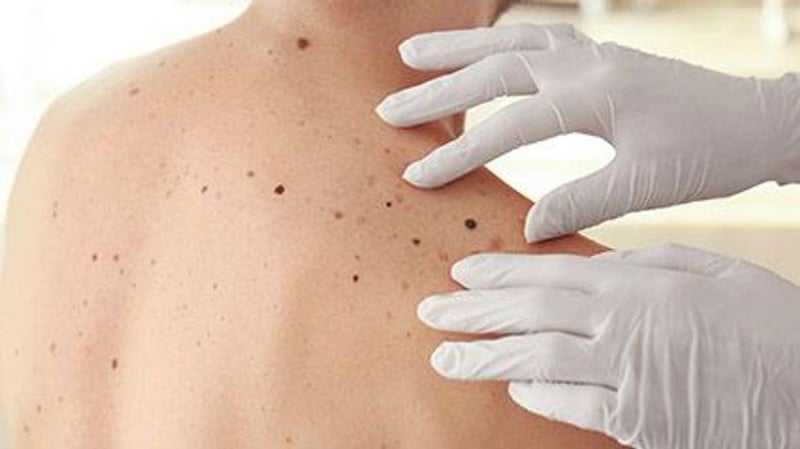Get Healthy!

- Posted June 20, 2022
Skin Tags? Moles? Products Promising to Treat Them Can Do Real Harm
It may seem tempting to remove a mole or skin tag you don't like with a product that promises to make them disappear quickly.
Don't do it, experts say.
Dermatologists and the U.S. Food and Drug Administration both warn about the dangers of using unregulated products for do-it-yourself removal of moles, skin tags and another type of growth known as seborrheic keratoses.
Not only could doing so cause scarring and infection, but it can also mask skin cancer and make it harder for doctors to identify and treat promptly.
"There are several reasons that patients should avoid trying to treat moles at home. And that is certainly the most concerning... that cancer patients often mistake skin cancer for benign moles," said Dr. Chad Prather, a board-certified dermatologist in Baton Rouge, La. "We commonly see patients who have a skin cancer. It's been diagnosed and their initial process was to try to treat that at home with either physical means or sometimes these over-the-counter products."
That can cloud the diagnosis of very serious skin cancers, such as melanoma, Prather said.
The FDA released an advisory earlier this month warning that there is no approved prescription or over-the-counter drug for treating moles, skin tags or seborrheic keratoses. Products sold for this purpose - such as ointments, gels, sticks and liquids - may contain high concentrations of salicylic acid and other harmful ingredients, the FDA warned.
The agency has received reports about people who developed permanent skin injuries, it noted in a news release.
Simply making the claim that it's "organic," "natural," "herbal" or "homeopathic" doesn't make it safe, according to the FDA.
A biopsy can provide information on how deep and wide a pigmented mole diagnosed as melanoma is, Prather said. That size helps guide treatment.
"We judge how bad a melanoma is by how deep it goes. And we really need that initial biopsy to know the true depth so that we can choose the most appropriate treatment method, whether it's surgery or checking lymph nodes or followed by immunotherapy," Prather said.
Products that contain acids can be caustic to the skin and are not typically used in dermatology practices where there are so many other treatment options, said Dr. Cameron Rokhsar, an associate professor of dermatology at Mount Sinai Hospital in New York City.
"I've seen non-healing ulcers that have taken months to heal and then permanent scars or pigmentary changes in the skin from it," Rokhsar said. "People don't have the medical expertise to distinguish benign skin tags and moles versus other dangerous things. And they may be putting this stuff on things that really should be shown to a doctor."
Treatment or removal depends on the diagnosis.
For a simple skin tag, a doctor may numb and snip it, finishing by applying medications to stop the bleeding, all of that in a sterile manner to minimize infection risk and scarring. Seborrheic keratosis may be removed with a blade, frozen or cauterized, if small. Sometimes even a laser is used.
"We have a lot of modalities for treatment at our disposal, which are obviously safe and time-tested medically," Rokhsar said. "We just have such better modalities than acids."
Whether to have something benign removed is up to the individual.
A board-certified dermatologist can give someone a proper diagnosis and can advise someone on the right method for removing the lesion if a person doesn't like its appearance or it's bothering them.
"Oftentimes, the insurance companies pay for that anyway if something is growing or something is getting irritated. These are covered issues," Rokhsar noted.
Any new growth that lasts more than three or four weeks should be evaluated by a dermatologist, Prather said. Warning signs that would warrant a visit to a dermatologist include scaliness, a pearly or shiny look to the lesion and a change in pigmentation or color.
"We recommend a once-a-year screening if the patient has no history of cancer or family history of cancer. For patients who have [a history of] skin cancer, which is the most common cancer, one in five patients will have some skin cancer in their life. For those patients, they're checked a little more frequently. Often every three to six months," Prather said.
If someone has used one of these products and has had an adverse effect, they can use the FDA's MedWatch Safety Information and Adverse Event Reporting Program, completing and submitting a form online or calling the FDA at 1-800-332-1088 to request a form.
More information
The American Cancer Society has more information on skin cancer.
SOURCES: Cameron Rokhsar, MD, dermatologist and laser surgeon, New York Cosmetic, Skin and Laser Surgery Center, and associate professor, dermatology, Mount Sinai Hospital, New York City; Chad Prather, MD, dermatologist, Sanova Dermatology, Baton Rouge, La.; U.S. Food and Drug Administration, news release, June 9, 2022








